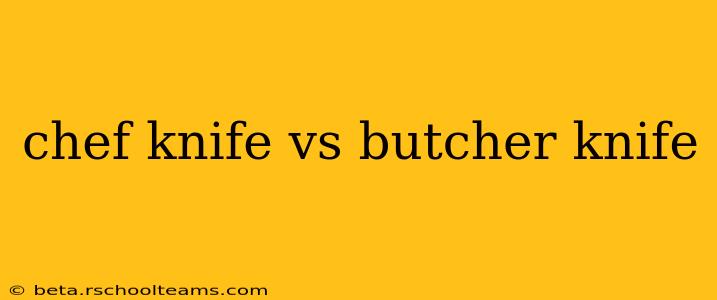Choosing between a chef's knife and a butcher knife can feel overwhelming, especially for home cooks. Both are essential kitchen tools, but their distinct designs cater to different tasks. This comprehensive guide will delve into the key differences, helping you decide which knife—or perhaps both—deserves a spot in your knife block.
What is a Chef's Knife?
The chef's knife, often called a cook's knife, is the workhorse of most kitchens. Its versatility is unmatched. This typically 8-inch blade (though sizes vary) boasts a curved edge, allowing for rocking motions that make chopping, dicing, mincing, and slicing incredibly efficient. The pointed tip facilitates more precise work like piercing and separating ingredients. The chef's knife excels at a wide range of tasks, making it a staple for many home cooks.
What is a Butcher Knife?
The butcher knife, also known as a breaking knife, is a heavy-duty tool designed for processing larger cuts of meat. Its blade is typically longer and thicker than a chef's knife, often ranging from 6 to 15 inches. The blade is typically straighter, with a less pronounced curve, making it ideal for cleanly slicing through bone, cartilage, and sinew. Its robust construction and superior strength make it perfect for breaking down whole poultry, butchering larger cuts of meat, and performing other demanding tasks.
Chef Knife vs. Butcher Knife: Key Differences
| Feature | Chef's Knife | Butcher Knife |
|---|---|---|
| Blade Length | Typically 8 inches (variations exist) | Typically 6-15 inches |
| Blade Shape | Curved | Generally straight or slightly curved |
| Blade Thickness | Relatively thin | Significantly thicker |
| Weight | Lighter | Heavier |
| Primary Use | Chopping, dicing, mincing, slicing | Butchering meat, breaking down large cuts |
| Versatility | Highly versatile | Less versatile, specialized for meat processing |
What are the best uses for a chef's knife?
The chef's knife shines in its versatility. It's your go-to for:
- Chopping vegetables: Onions, carrots, peppers—the chef's knife handles it all with ease.
- Dicing: Creating even cubes for salads or stir-fries is a breeze.
- Mincing herbs: Fine chopping of herbs is achievable with the rocking motion.
- Slicing: From slicing tomatoes to carving roasts (smaller ones), it offers clean cuts.
What are the best uses for a butcher knife?
The butcher knife is a powerful tool best suited for:
- Breaking down whole poultry: Its strength makes separating joints and removing bones straightforward.
- Butchering larger cuts of meat: Slicing through bone and cartilage is effortless with this knife.
- Processing game: The robust construction stands up to the challenges of processing wild game.
- Cutting through tougher materials: Its thickness and strength make it ideal for anything requiring significant force.
Which knife should I buy first?
For most home cooks, the chef's knife is the better first purchase. Its versatility makes it an indispensable tool for everyday cooking. Once you've mastered using a chef's knife and find yourself regularly handling larger cuts of meat or needing to break down whole birds, then a butcher knife is a worthwhile addition.
Can I use a chef's knife for butchering?
While you can attempt to butcher meat with a chef's knife, it's not recommended. The thin blade is more prone to bending or breaking when encountering bone, and it simply won't be as efficient for the task. It's best to use the right tool for the job to ensure safety and efficiency.
What type of steel is best for chef and butcher knives?
High-carbon stainless steel is a popular choice for both chef's and butcher knives due to its balance of hardness, durability, and stain resistance. However, other steels like high-carbon German steel offer superior edge retention but may require more care.
How do I care for my chef and butcher knives?
Proper knife care is crucial for maintaining sharpness and extending their lifespan. Always hand wash your knives with warm, soapy water and dry them immediately to prevent rust. Regular sharpening is essential, and storing them properly in a knife block or magnetic strip will prevent damage.
By understanding the distinctions between a chef's knife and a butcher knife, you can make an informed decision about which blade will best serve your culinary needs. Remember, owning both allows you to tackle any kitchen task with confidence and precision.
